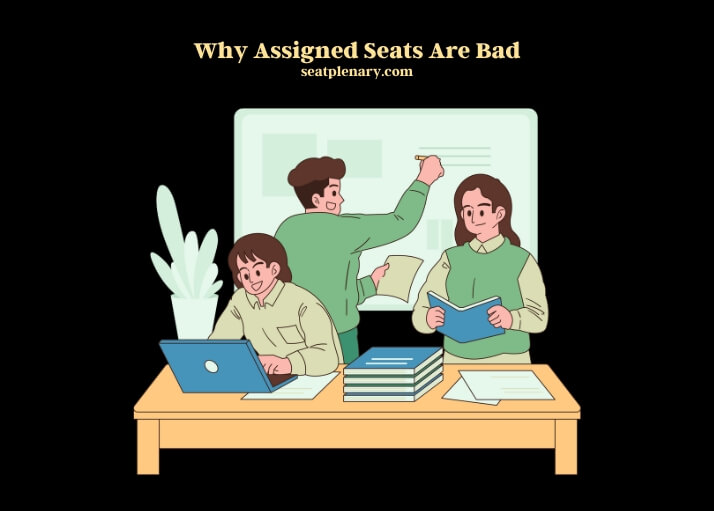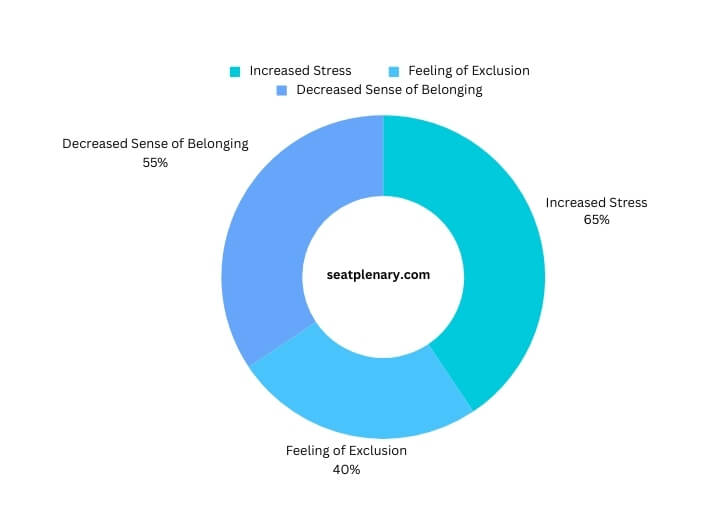Assigned seating in classrooms can stifle student autonomy and creativity. It often limits opportunities for social interaction and collaboration among students.
Assigned seating arrangements in educational settings can have a range of negative impacts on students. By restricting where students can sit, these policies limit their ability to choose who they interact with, potentially hindering the development of social skills and the formation of diverse friendships. This lack of choice can also affect students’ engagement and motivation, as they may feel less connected to their learning environment when they have no control over it.
Furthermore, assigned seating does not accommodate different learning styles and needs. Some students may perform better when they are near the front of the room or have the ability to choose a quiet corner, while others might thrive when sitting near friends who can provide support and collaboration.
The rigidity of assigned seating also contributes to a monotonous classroom atmosphere, which can decrease students’ enthusiasm for learning. Allowing students some degree of choice in where they sit can foster a more inclusive, dynamic, and engaging classroom environment, encouraging better academic and social outcomes.

Autonomy and Choice Undermined
Assigned seating in classrooms is often seen as a necessary tool for maintaining order, but it comes with unintended consequences for student autonomy and choice. This approach restricts students’ ability to make decisions about their learning environment, which can dampen their enthusiasm and engagement in the classroom.
The ability to choose where to sit can empower students, fostering a sense of independence and responsibility towards their learning.
Assigned seating can hinder the development of social skills, as students are limited in their opportunities to interact with different peers. This lack of choice can lead to a decrease in motivation and satisfaction, as students feel less control over their learning environment, impacting their overall educational experience.
Classroom Dynamics Altered
The structure of assigned seating significantly affects classroom dynamics, influencing both student behavior and teacher-student interactions. While the intention behind assigned seating is often to minimize disruptions and enhance focus, it can also lead to increased tension and less natural social interactions among students. This setup can create an atmosphere where students are less likely to participate actively and engage with the lesson.
It can strain the relationship between students and teachers, as students may feel they are not trusted to make responsible choices. The rigidity of assigned seating does not accommodate the diverse needs of students, potentially leading to a less inclusive and flexible learning environment.
Academic Performance Impacted

Study on Seating Arrangements and Student Performance
| Seating Arrangement | Average Grade Increase | Student Engagement Level |
| Student-Selected | +5% | High |
| Assigned Seating | +1% | Moderate |
Research indicates that the flexibility in seating arrangements can positively affect academic outcomes. The table above summarizes findings from a study comparing student-selected seating to assigned seating. Students in environments where they could choose their seats showed a higher level of engagement and a notable increase in academic performance.
This suggests that the ability to choose can enhance focus and participation, leading to better learning outcomes. Assigned seating, by contrast, may not cater to the varied learning styles and preferences of students, potentially stifacing their academic potential.
Social Implications in the Classroom
Assigned seating can have profound social implications within the educational setting, affecting students’ ability to form and maintain relationships. This enforced structure can create barriers to social integration and limit students’ exposure to diverse perspectives.
It can inadvertently reinforce social hierarchies and exclusions, as students have fewer opportunities to interact with peers outside their immediate vicinity. This segregation can contribute to a classroom environment that lacks unity and inclusiveness, hindering the development of a supportive and collaborative learning community.
Mental Health Considerations
Student Perceptions on Assigned Seating and Mental Health
| Perception | Percentage of Students |
| Increased Stress | 65% |
| Feeling of Exclusion | 40% |
| Decreased Sense of Belonging | 55% |

The psychological impact of assigned seating on students is significant, with many reporting increased stress and anxiety. The data in Table 2 highlights the negative perceptions students have towards assigned seating, including feelings of exclusion and a decreased sense of belonging.
These feelings can be detrimental to students’ mental health and well-being, affecting their ability to concentrate and succeed academically. Providing students with more autonomy over their seating choices can help alleviate these pressures, fostering a more supportive and inclusive classroom environment.
FAQs
Does Assigned Seating Stifle Creativity?
Assigned seating can inadvertently put a damper on students’ creative expression. By confining students to a specific spot, it limits their ability to interact with a diverse group of peers, potentially stifling collaborative creativity. Creative learning often thrives in environments where students can freely choose their collaborators, fostering a dynamic exchange of ideas.
In a rigid seating arrangement, the opportunity for spontaneous group work or discussions with different classmates is reduced, possibly leading to a homogeneous way of thinking and limiting exposure to varied perspectives that could spark innovative ideas.
Can Assigned Seats Affect Student Confidence?
Yes, assigned seating can have a negative impact on student confidence. Being placed in a seat without any input can make students feel powerless, affecting their self-esteem. For some, being seated away from friends or in parts of the classroom where they feel less comfortable can increase anxiety and decrease their willingness to participate in class discussions.
This lack of participation can further diminish their confidence in their abilities, creating a cycle of disengagement and lowered self-esteem. Allowing students some degree of choice in seating can help them feel more secure and confident in their learning environment.
How Does Assigned Seating Influence Peer Relationships?
Assigned seating can significantly influence the development of peer relationships in the classroom. By dictating who students sit next to, it limits their ability to naturally form friendships and can segregate students into cliques. This enforced proximity does not guarantee positive interactions and may even exacerbate tensions between students who do not get along.
Conversely, giving students the freedom to choose their seats can encourage them to interact with a wider range of classmates, fostering a more inclusive and friendly classroom atmosphere where diverse relationships can flourish.
Does Assigned Seating Impact Learning Flexibility?
Assigned seating can restrict learning flexibility by limiting students’ ability to engage in different learning activities that require movement or collaboration with various peers. In today’s educational landscape, where differentiated instruction and flexible seating options are increasingly recognized for their benefits, assigned seating feels antiquated.
It does not accommodate different learning styles or the need for students to move to different stations, work in groups, or have quiet, individual spaces. This lack of flexibility can hinder the effectiveness of teaching strategies intended to cater to the diverse needs of students.
Can Assigned Seating Contribute to Classroom Monotony?
Assigned seating can contribute to a sense of monotony in the classroom. Sitting in the same place every day can make the learning environment feel stale and predictable, which may lead to disengagement among students.
The excitement and novelty of entering a classroom and choosing a spot based on one’s mood, social preferences, or learning needs are lost. This monotony can dull students’ enthusiasm for coming to class and sap their energy, making it harder to maintain interest and focus throughout the school year.
How Does Assigned Seating Affect Student Autonomy?
Assigned seating can significantly reduce student autonomy, making them feel like they have little control over their learning environment. Autonomy is crucial for fostering a sense of responsibility and ownership over one’s education.
When students are allowed to make choices, even as simple as where to sit, they are more likely to feel engaged and invested in their learning. Assigned seating sends a message that their preferences and comfort do not matter, which can be demotivating. Encouraging student choice can help cultivate a more empowering and autonomous classroom culture.
Summary
The practice of assigned seating in classrooms, while intended to maintain order and focus, has several drawbacks. It can undermine student autonomy, alter classroom dynamics in a way that is not always conducive to learning, impact academic performance negatively, have adverse social implications, and affect students’ mental health.
Considering these factors, educators should weigh the benefits of assigned seating against its potential to hinder the development of a positive and effective learning environment.
